- Bernard Preston homepage
- Legumes
- Glycemic Response to Fava Beans
Glycemic response to fava beans
The glycemic response to fava beans at first glance is surprisingly high.
High GI foods cause a rapid rise in blood glucose, with a corresponding squirt of insulin from the pancreas required to contain and avert this threat to the linings of blood vessels. Should we be unable to produce the hormone (type 1 diabetes) or have become resistant to it (T2DM) then our capillaries will be damaged and become inflamed; that is why diabetics lose toes, go blind and suffer from heart attacks and strokes.
Clearly if we value our lives we need to avoid highly glycemic foods; are fava beans among them?
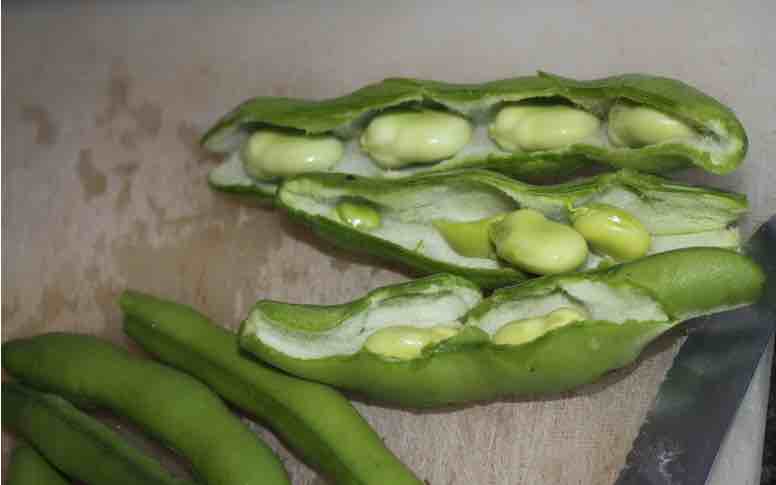
The answer is a yes and a no. Like most other foods it all depends on how you refine, prepare and cook them. Whole grain wheat and rice are not highly glycemic, but most of that bought from the supermarkets today is downright dangerous for our health.
I find it very interesting that neither my chickens or dogs, nor the creepy crawlies in my worm farms will touch white bread; nor will you find weevils in refined flour. Only humans will eat it.
Generally speaking legumes have a very low glycemic index; the carbohydrate in them is released very slowly into the blood stream, making them an ideal source of starch for energy. Also, the protein found coupled with the carbs in them lowers the GI even further. So why do broad beans have such a high GI?
Do broad beans have a high GI?
No they do not, if you enjoy them the way nature prepares them. The problem is that they go soft very quickly after reaping so, if you can get them at all, you will find that farmers let them grow old and then the cook is expected to do a double-podding.
First it is recommended that you must remove the outer shell, as shown above, then you must cook them and by gently squeezing the bean squirt the inner core out of its little sheath; then what remains is certainly highly glycemic.
The only solution is to grow favas yourself, reap them young and tender and cook immediately with the outer shell and inner pod, just like you would a pole or bush bean.
So why eat them then if it is so much trouble? Because firstly, they have the greatest amount of vegetable protein of all the legumes, after soya and secondly because they are the only significant source of L-Dopa.
That is a very important resource for the body to synthesise an essential neurotransmitter called dopamine. Have you heard of Parkinson's disease? Grow and enjoy young green broad beans.
Skinning fava beans
Young whole broad beans in their pods are also very delicious. Those that are skinned are highly glycemic; they have lost most of their fibre and much of the L-dopa.
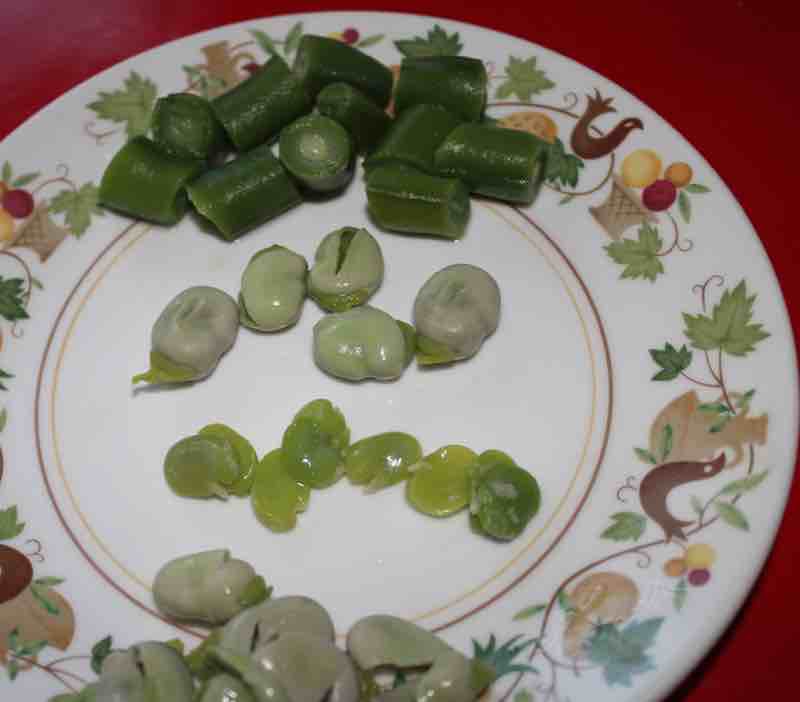
Top: Whole broad beans.
Shelled broad beans: the right way to enjoy the beans.
Double podded broad beans: this is the way modern cooks would have you eat them.
Bottom: Empty skins.
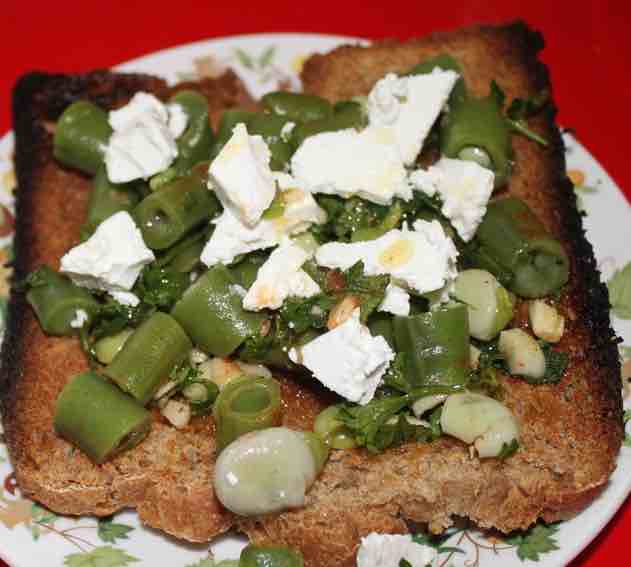 Broad bean bruschetta
Broad bean bruschettaOn toast they are a great favourite and take at most ten minutes to put together; add five more if you know how to plant broad beans.
Glycemic response to fava beans
Glycemic response to fava beans is warped because tests are done after the fruit is first podded and then popped out of its skin; most of the fibre is removed.
Allowing the beans to grow old so that you have to remove the tough outer skin is just a bad practice. Like all veggies they are much nicer when young and freshly picked.
And it is bad nutrition too; having popped the old beans out of their skins they now create havoc with your blood glucose. In scientific jargon they have a really quite large glycemic response.
So
perhaps you just love them and so enjoy dishes like these but if you
are interested in going into the subject more deeply then this fava beans nutrition link will inspire you. They are profoundly important in preventing some common very serious conditions of old age; Parkinson's disease[1], ulcers and macular degeneration.
Just don't double-pod them; it adversely affects the glycemic response to fava beans.
When to pod fava beans
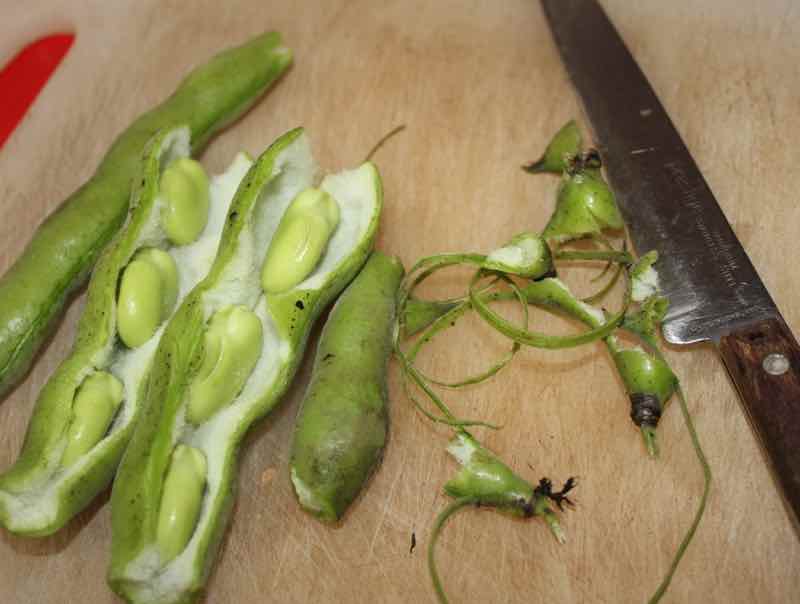
As stated above many of the important nutrients of fava beans are to be found in the pod; also the fibre without which the glycemic-index rises. However they do reach a point where that skin can become unpleasantly tough and fibrous.
I have simple rule of thumb. Strip each pod and, if it produces a string, then remove the beans and discarding the shell.
If however it produces no string, then I slice the whole bean and include the pod in the dish that I am cooking.
Dopamine is the happy hormone
Dopamine is known as the "happy hormone;" it is intimately involved in the deeply satisfying response to many foods and experiences by titivating cells in the hypothalamus.
Without dopamine we are miserable; and research is now fingering the role it plays in many of the aberrant behaviours of our children. ADHD is alarmingly on the rise; the solution is not drugs but a steady supply of fava beans for the L-dopa; and far less of the ultra-processed foods typically found in grocery stores today.
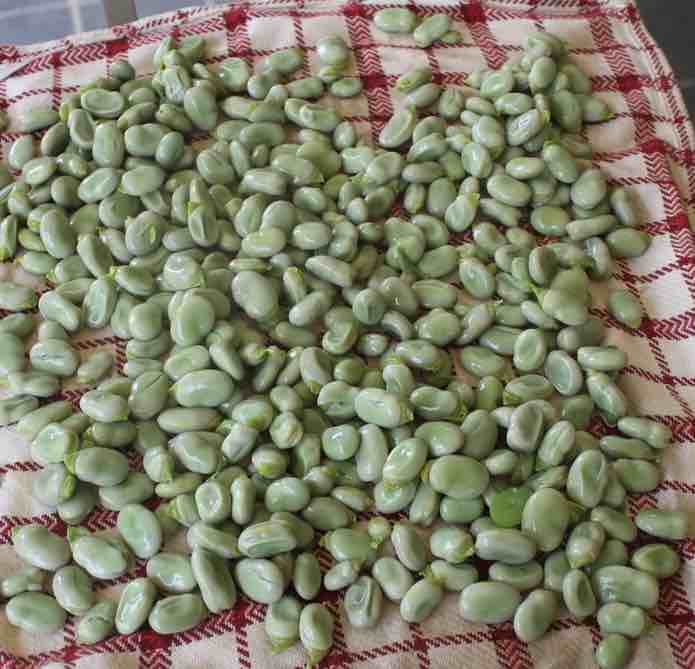 Blanche and freeze your fava beans
Blanche and freeze your fava beansL-dopa is a powerful antioxidant
L-dopa is an "amine," a compound that has powerful reducing properties that enable it to scavenge dangerous "reactive oxygen species" that damage our genes.
When browsing use right click and "Open Link in New Tab" or you may get a bad gateway signal.
Newsletter
Our newsletter is entitled "create a cyan zone" at your home, preserving both yourself and Mother Earth for future generations; and the family too, of course. We promise not to spam you with daily emails promoting various products. You may get an occasional nudge to buy one of my books.
Here are the back issues.
- Lifestyle and ideal body weight
- What are ultra-processed foods?
- Investing in long-term health
- Diseases from plastic exposure
- Intensive lifestyle management for obesity has limited value
- A world largely devoid of Parkinson's Disease
- The impact of friendly bacteria in the tum on the prevention of cancer
- There's a hole in the bucket
- Everyone is talking about weight loss drugs
- Pull the sweet tooth
- If you suffer from heartburn plant a susu
- Refined maize meal and stunting
- Should agriculture and industry get priority for water and electricity?
- Nature is calling
- Mill your own flour
- Bake your own sourdough bread
- Microplastics from our water
- Alternative types of water storage
- Wear your clothes out
- Comfort foods
- Create a bee-friendly environment
- Go to bed slightly hungry
- Keep bees
- Blue zone folk are religious
- Reduce plastic waste
- Family is important
- What can go in compost?
- Grow broad beans for longevity
- Harvest and store sunshine
- Blue zone exercise
- Harvest and store your rainwater
- Create a cyan zone at your home
Did you find this page interesting? How about forwarding it to a friendly book or food junkie? Better still, a social media tick would help.
- Bernard Preston homepage
- Legumes
- Glycemic Response to Fava Beans
Address:
56 Groenekloof Rd,
Hilton, KZN
South Africa
Website:
https://www.bernard-preston.com